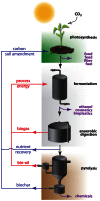Towards a carbon-negative sustainable bio-based economy
- PMID: 23761802
- PMCID: PMC3669761
- DOI: 10.3389/fpls.2013.00174
Towards a carbon-negative sustainable bio-based economy
Abstract
The bio-based economy relies on sustainable, plant-derived resources for fuels, chemicals, materials, food and feed rather than on the evanescent usage of fossil resources. The cornerstone of this economy is the biorefinery, in which renewable resources are intelligently converted to a plethora of products, maximizing the valorization of the feedstocks. Innovation is a prerequisite to move a fossil-based economy toward sustainable alternatives, and the viability of the bio-based economy depends on the integration between plant (green) and industrial (white) biotechnology. Green biotechnology deals with primary production through the improvement of biomass crops, while white biotechnology deals with the conversion of biomass into products and energy. Waste streams are minimized during these processes or partly converted to biogas, which can be used to power the processing pipeline. The sustainability of this economy is guaranteed by a third technology pillar that uses thermochemical conversion to valorize waste streams and fix residual carbon as biochar in the soil, hence creating a carbon-negative cycle. These three different multidisciplinary pillars interact through the value chain of the bio-based economy.
Keywords: anaerobic digestion; biochar; biomass; fermentation; lignocellulose; pyrolysis; saccharification.
Figures



References
-
- Abramson M., Shoseyov O., Shani Z. (2010). Plant cell wall reconstruction toward improved lignocellulosic production and processability. Plant Sci. 178 61–72 10.1016/j.plantsci.2009.11.003 - DOI
-
- Amonette J. E., Joseph S. (2009). “Characteristics of biochar: microchemical properties,” in Biochar for Environmental Management: Science and Technology, eds Lehmann J., Joseph S. (London: Earthscan; ) 33–52
LinkOut - more resources
Full Text Sources
Other Literature Sources

